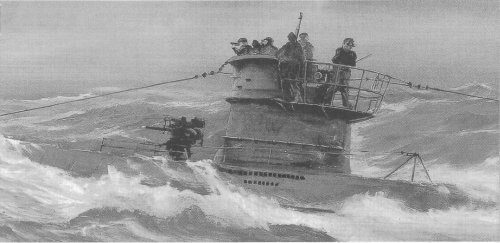- Author
- Gregory, Mackenzie J.
- Subjects
- WWII operations
- Tags
-
- RAN Ships
- HMAS Australia II
- Publication
- September 2001 edition of the Naval Historical Review (all rights reserved)
One of the crucial decisions made during the Battle of the Atlantic was to relocate the Western Approaches Command on the 7th of February, 1941 from Plymouth to Liverpool.
Admiral Sir Martin Dunbar-Nasmith had previously been in control at Plymouth whilst the main convoy route to and from North America was sent around the south of Ireland.
He now became C in C at Plymouth, and the convoy route was moved to the north of Ireland, and Liverpool became the logical choice to locate the Western Approaches Command structure.
Admiral Sir Percy Noble was given the onerous task of C in C Western Approaches, his Headquarters set up beneath Derby House, deep below street level, in a bomb-proof area, with a large Operations Room linked to the Admiralty, and duplicating the London Trade Plot.
The huge wall chart carried the plot showing the position of all Allied Convoys, their Escorts, and the estimated or known position of all German U-Boats currently at sea.
This new HQ gained information from the Operational Intelligence Centre, the Submarine Tracking Room, and the Air Ministry in London.
Control of Number 15 Coastal Command under the leadership of Air Vice Marshal J.M. Robb also moved from Plymouth to Liverpool.
It was essential that co-operation between both the Royal Navy and Royal Air Force was of the highest order if maximum toll was to be taken against the U-Boats. Towards this objective the complete operational control of RAF Coastal Command was passed to the Admiralty on the 11th of April 1941.
Admiral Sir Percy Noble worked assiduously in his Western Approaches Command to keep open Britain’s sea lifeline from North America, and probably he was not given the kudos that should have accrued to him for the result he attained here.

To win the Battle of the Atlantic was paramount for Britain to survive. It carried far more significance than winning the Battle of Britain in the air.
The invasion of Europe in 1944, spelling out, the beginning of the end for Germany, could not have been mounted if the German U-Boats had been the victors of the Battle of the Atlantic.
Admiral Sir Max Horton, in November 1941 assumed command at Western Approaches HQ. He remained in this position until the war ended, an ex submariner, his dynamic leadership played a vital role in the final defeat of the U-boat menace.
It is May of 1943 that is usually accepted as the month that marked victory for Allied Naval forces over the German U-Boat arm in the Atlantic.
Fifty years later it was decided to commemorate this famous victory at Liverpool in May of 1993.
Why choose Liverpool as the venue for Battle of the Atlantic 93 (BA 93)?
Throughout the years of WW II, Liverpool was Britain’s main convoy port, the vital lifeline was maintained with the United States and Canada, it was crucial both for Britain’s survival and the ultimate Allied victory.
During WW II, over 1,000 convoys arrived in the Mersey, on average 3 or 4 per week.
As already noted, Western Approaches Command was based in Liverpool from 1941 to the end of the war.
Warships and Merchant ships were repaired and built on Merseyside, and thousands of Liverpool people were involved here in the war effort.
Liverpool chose itself as the venue for the Battle of the Atlantic 93 celebrations, no other site came close to this famous port.
HMAS Australia
As a Midshipman in HMAS Australia, during 1940/1941, I had been involved on convoy duties working out of Liverpool.
As part of these 50th anniversary celebrations, Her Majesty the Queen had reopened Western Command Headquarters after extensive rebuilding that cost about a million pounds sterling.
Thus, in May of 1993, I was delighted to return to Liverpool, and be able to visit this site, again set up as it had operated during those dark days, when Britain’s survival depended on the skill of the sailors manning the Naval escorts, and the courage of the merchant crews, as they fought against the unrelenting waters of the North Atlantic, and the dedicated and determined U-Boat crews.




